
Why Surrey needs a greener future climate change delivery plan
To recognise the urgency of the problem
The evidence that climate change is real is beyond doubt and its effects are already being felt across the world [footnote 1]. An increase in man-made greenhouse gases will impact on the health, wellbeing and finances of Surrey's residents, businesses, landscapes and biodiversity for many years to come. Along with action being taken across the globe, we intend for Surrey to play its part by reducing its dependency on fossil fuels.
To create the step-change needed to meet our net-zero targets
In 2020, Surrey's Climate Change Strategy was published in response to Local Authorities [footnote 2] declaring a climate emergency and setting a target for Surrey to become net-zero carbon [footnote 3] by 2050. This Delivery Plan sets out what needs to happen over the next five years; the first step in a 30-year-long delivery phase.
To get everyone involved
No one in isolation can solve climate change, so the Delivery Plan shows how public sector, businesses, residents and communities can work together to bring about faster change. It identifies actions which Local Authorities will take to support those who live, work and visit Surrey to reduce carbon emissions and adapt to the impacts of climate change.
Footnotes
[Footnote 1] Intergovernmental Panel on Climate Change 6th Assessment Report, August 2021.
[Footnote 2] Local Authorities includes Surrey County Council and 11 Borough and District Councils in Surrey.
[Footnote 3] For the purposes of this document "carbon" refers to carbon dioxide and other greenhouse gas emissions that cause global warming.
Summary of the impact by 2050 if we do nothing
Summary of the impact by 2050 if we do nothing [footnote 4]:
- An increased likelihood of heatwaves with temperatures up to 37.1ºC.
- Hotter, drier summers with average daily temperatures rising by up to 2.2ºC.
- Warmer winters with average daily temperatures rising by up to 1.5ºC.
- Droughts becoming more common as summer rainfall falls by 20%.
- A higher risk of flooding with winter rainfall increasing by 10%.
Footnote
[Footnote 4] Based on the UK Climate Change Projections 2018 future greenhouse gas scenario 4.5 which represents a rise in global temperature of 2.4ºC by 2081-2100.
What Surrey needs to do to tackle climate change
Understand sources of carbon emissions
In 2018 emissions attributable to the county's 2050 net zero target totalled 6.6 million tonnes of carbon dioxide equivalent (MtCO2e). Transport and buildings make up 94% of carbon emissions produced from petrol and diesel vehicles, gas heating and electricity consumption in the county. Emissions relating to the consumption of goods and services by Surrey residents and businesses are estimated to be between 14-17 MtCO2e; 2-3 times greater than those measured as part of the net zero targets. [Footnote 5]
Footnote
[Footnote 5] Surrey Carbon Baseline Study, University of Surrey, April 2021.
Surrey carbon emissions in 2018
Surrey carbon emissions in 2018 [footnote 6].
In 2018, 6.6 million tonnes of carbon dioxide (CO2) were emitted, made up of:
 Residential gas: 21%
Residential gas: 21% Residential electricity 9%
Residential electricity 9% Other residential energy 1%
Other residential energy 1% Non-residential gas: 7%
Non-residential gas: 7% Non-residential electricity : 12%
Non-residential electricity : 12% Other energy and industrial emissions: 10%
Other energy and industrial emissions: 10% Road transport: 40%
Road transport: 40% Other transport: 1%
Other transport: 1% Waste and agriculture: 4%
Waste and agriculture: 4% Land use: -4%
Land use: -4%
Negative numbers show where carbon is absorbed from the atmosphere. Percentage changes do not add up to exactly 100% due to rounding.
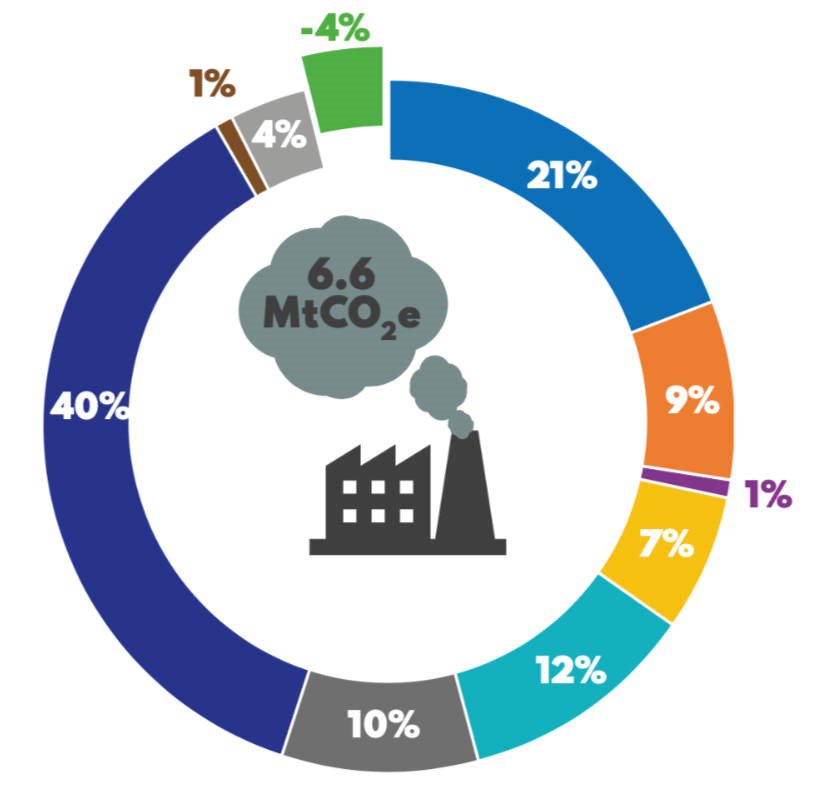
Footnote
[Footnote 6] Estimate of the carbon emissions in Surrey have been derived from scope 1 and 2 emissions from the SCATTER pathways tool.
Emissions from all Surrey local authorities in 2019/2020
Emissions from all Surrey local authorities in 2019/2020 [footnote 7]
In 2019 to 2020, 45,056 tonnes of carbon dioxide (CO2) were emitted, made up of:
- Heating: 36%
- Transport: 12%
- Electricity : 51%
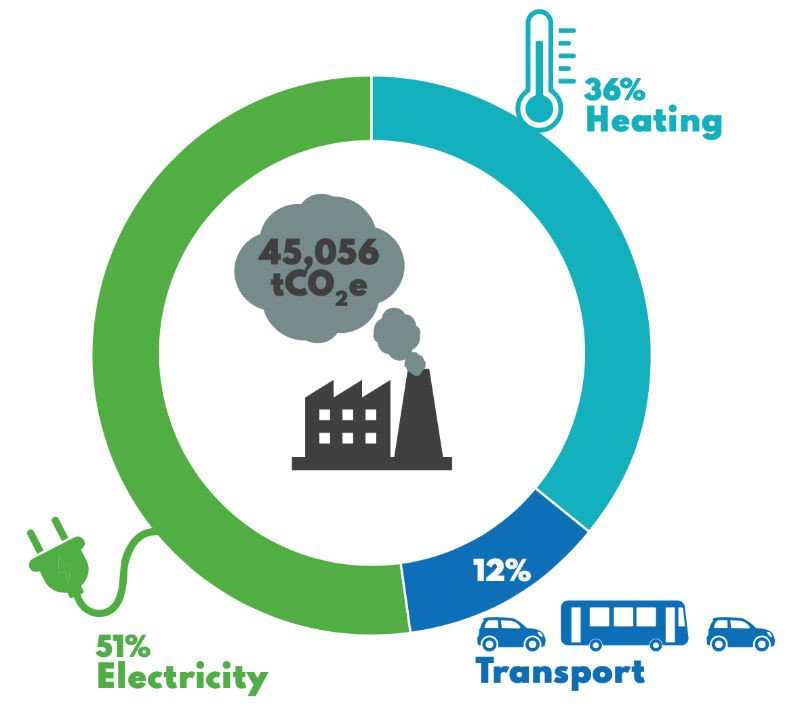
Be as ambitious as possible
By 2025, we need to reduce carbon emissions by between 1.3 and 2.3 million tonnes. That's a 19%-36% [footnote 8] saving from 2018 levels. Achieving a 19% reduction in emissions over a five-year period is extremely challenging, requiring levels of funding and policy changes that are not currently in place. We believe that reaching a reduction in carbon emissions of 36% is necessary but likely to be impossible unless fundamental changes in national policy and funding levels occur.
Footnote
[Footnote 7] Estimate of carbon emissions from Local Authorities have been derived from scope 1 and 2 emissions inventories for all Surrey Local Authorities.
[Footnote 8] Estimates of carbon emission reductions have been taking from SCATTER pathways tool.
Our pathway to net zero reduction of 1.3 tonnes of carbon by 2025
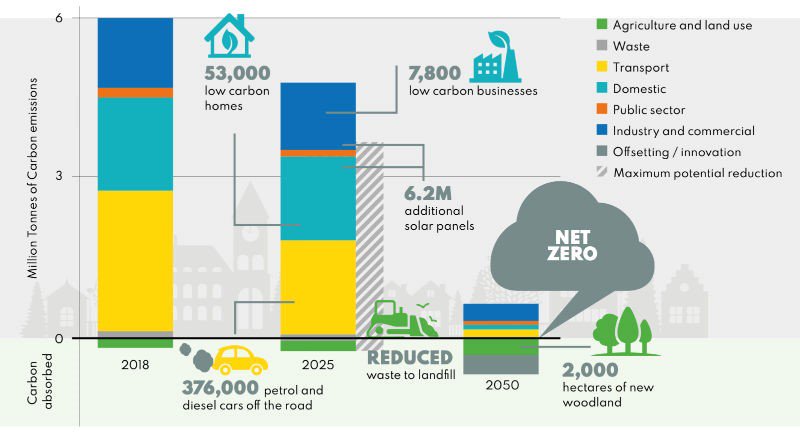
Estimate the scale of the challenge
Creating deep emissions cuts requires us to reduce our dependency on fossil fuels and move towards low carbon alternatives. 53,000-110,000 homes, 7,800-25,300 businesses, and 9,900-19,900 public sector buildings need to become more energy efficient and move away from gas heating. 376,000- 493,000 fossil-fuel vehicles need to be avoided or replaced by electric vehicles, walking, cycling or public transport. As we move towards electric vehicles and heating, Surrey needs to contribute to the decarbonisation and management of the electricity grid by increasing the capacity of renewable energy by 1244 megawatt (MW) of low carbon electricity through the installation of about 6.2 million solar panels and other forms of renewable energy. Consumption emissions generated outside of Surrey must be reduced by moving towards more local and sustainable products and services with less waste.
Avoid and reduce future impacts
Carbon emission reduction can be accelerated, and further emissions prevented, by putting in place the planning and infrastructure that is consistent with a low-carbon future. A Climate Change Adaptation and Resilience Plan for Surrey is being developed, which sets out how we manage risk and try to minimise the impacts of climate change on health and wellbeing, buildings and infrastructure, businesses, agriculture, and our natural environment.
Reap the wider benefits
Tackling Climate Change is about changing things for the better and will result in; reducing fuel bills through better quality housing, reducing harmful air pollution by reducing the amount motor vehicles and gas boilers, creating local sustainable high streets and jobs, improving the environment through less waste, and supporting our wildlife.
Where change needs to happen
Everyone needs to act
The scale and complexity of the challenge is such that everyone needs to play a role in tackling climate change. The four areas of focus reflect changes that need to happen: in our communities (Greener Futures Communities), our public sector (One Net Zero Public Estate), our supporting infrastructure (Build Back Greener) and our land (Grow Back Greener).
Delivery plan programmes
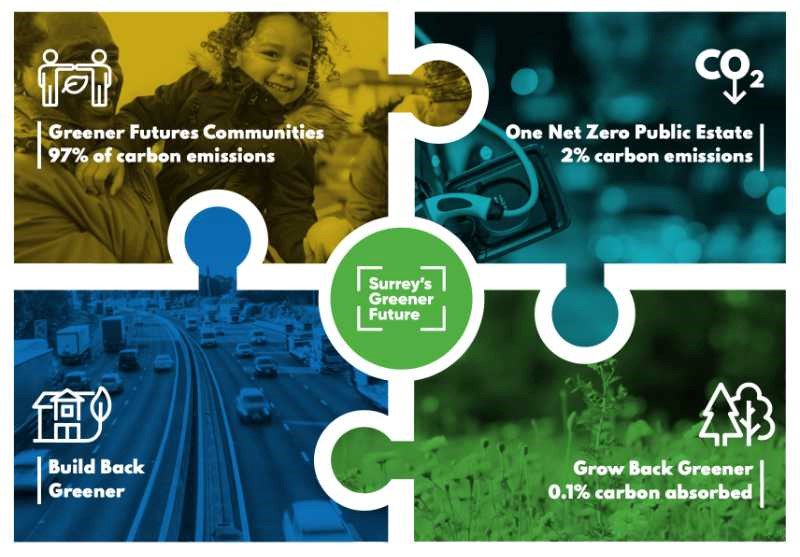
 Greener Futures Communities
Greener Futures Communities
95% of Surrey's carbon emissions are generated from the buildings and vehicles of our 1.2 million residents and 65,000 businesses. Many face significant challenges to decarbonise. Individuals can reduce their carbon footprint by changing the way they travel, shop, eat and by reducing their waste. Homeowners and landlords can create energy efficient buildings which use low-carbon heat pumps, and maximise on-site renewable energy. Businesses can set ambitious climate reduction targets and offer low-carbon goods and services to residents. Communities can work to improve neighbourhoods by supporting community energy, planting trees and protecting green spaces, travelling via active and public transport modes and developing sustainable commerce and waste reduction projects.
 One Net Zero Public Estate
One Net Zero Public Estate
The buildings of Local Authorities, Surrey County Council, NHS, Police and others generate around 2% of carbon emissions. They can set ambitious targets to reduce emissions across their organisations, services and supply chains; putting sustainability at the heart of every decision.
 Build Back Greener
Build Back Greener
Supporting infrastructure can make it possible for residents and businesses to make low carbon travel and lifestyle choices and avoid the cost of expensive retrofit. To ensure that everything we build is fit for a low carbon future, planning authorities and developers can support net-zero developments which are adapted to the impacts of climate change and achieve biodiversity net-gain.
 Grow Back Greener
Grow Back Greener
Land naturally mitigates flooding and creates cool spots during hot weather, supporting many biodiverse habitats. Through soil and vegetation, the land can absorb 4% of Surrey's carbon emissions, tempered by emissions produced by livestock. By improving land management practices, land owners and managers, including Local Authorities, can enhance nature's ability to store carbon, reduce flooding, provide shade and support biodiversity.
The role of local authorities
To take action
Around 70 actions have been identified, which build on action already being undertaken by the Surrey Local Authorities.
- Elmbridge's climate change action
- Epsom and Ewell's climate change action
- Guildford's climate change action
- Mole Valley's climate change action
- Reigate and Banstead's climate change action
- Runnymede's climate change action
- Surrey Heath climate change action
- Tandridge's climate change action
- Waverley's climate change action
- Woking's climate change action
As well as setting ambitious targets to reduce emissions in our own organisations, Local Authorities will act to enable others to make changes within their homes, businesses and neighbourhoods. This requires Local Authorities to consider climate change in everything they do. Working closely together, we will seek to maximise shared expertise and make delivery more uniform, efficient and cost effective.
To make change for the benefit of all
Local Authorities will seek to ensure that action on climate change also leads to a better Surrey overall. Whether it is lower fuel bills, cleaner air, less waste, more job opportunities or more accessible green spaces. Where residents may be disproportionately affected by the costs or impacts of climate change, we will make every effort to ensure that no one is left behind in the delivery of the county's target.
To bring people together and be a strong voice for change
A communication and engagement plan has been developed which seeks to put residents, communities and businesses at the heart of delivery; building a network of strong partnerships that are critical to delivering the county's targets. Local Authorities will continue to lobby for changes to Government policy and levels of investment, which will be a pivotal success factor in achieving Surrey's
targets.
To build firm foundations from which climate action can grow
As well as making rapid carbon emission reduction over the next five years, Local Authorities are looking to build greater change over the coming decades. A Greener Futures Finance Strategy will enable us to use new finance mechanisms to support climate action, focusing Local Authority finance on areas of greatest need. Local Authorities will trial innovative solutions to accelerate action and create new job opportunities. We will seek to minimise the need for carbon offsetting by reducing carbon emissions as much as possible, however, where there is a need to offset, the offsetting activity will be used to drive real change locally.
Surrey's Commitment
Surrey County Council has committed to:
- Embedding climate change considerations into everything we do as an organisation.
- Including climate change as part of all council decision making.
- Looking at best practice.
- Working collaboratively with the Government.
How we will know when we have succeeded?
The Greener Futures Board
Leaders representing businesses, residents, public sector and climate experts will oversee progress against the Delivery Plan. Recommendations made by the Board will be taken into account when decisions are made through the governance processes of Surrey's Local Authorities. The views, involvement and experiences of local people will be central in influencing the priorities, work and decisions of the Board. The Board's work will therefore be informed by engagement with residents through communication, participatory mechanisms and consultations.
Through two-way communication
A network of partners has been developed and will continue to be fostered. Feedback on the progress of action across Surrey will be captured in order to build momentum to support delivery.
Through regular monitoring
Compared with carbon emissions estimates in 2018, progress against Surrey's Climate Change Strategy will be reported on an annual basis which ensures that the Delivery Plan supports the level of change needed to achieve the 2030 and 2050 net-zero carbon targets.
The Greener Futures Board brings together a powerful alliance of key stakeholders to support the Delivery Plan, and steer its progress. They will work with a network of partners to mobilise climate action across the county alongside wider social, health and economic benefits.
 Greener future communities: Direct emissions
Greener future communities: Direct emissions
Aim
Empowering individuals and businesses to reduce emissions from energy consumption and transport, and maximise locally-produced renewable energy.
- Emission estimate in 2018:6.6 million tonnes of carbon dioxide equivalent (MtCO2e)
- Estimated annual emissions reduction by 2025: 1.2 MtCO2e [footnote 10] (equivalent to a 21% reduction compared to 2020).
- Of which, expected emission savings from new renewable energy: 292 thousand tonnes of carbon dioxide (ktCO2e) [footnote 11]
| Who needs to act | Expected progress by 2025 | Estimated annual carbon reduction by 2025 (ktCO2e) | What needs to happen | Local Authority action to 2025 |
|---|---|---|---|---|
| Vulnerable or low-income residents and landlords | 20% of fuel poor and vulnerable homes [footnote 12] | 118 | Elderly and economically disadvantaged residents are supported to install low carbon measures [footnote 13] that reduce bills and support independence. Landlords put low carbon measures on their buildings to reduce tenants' energy bills. | (1) Deliver retrofit programme funded by the Green Homes Grant Local Authority Delivery Fund [footnote 14]. (2) Work with social housing providers to accelerate low carbon measures for social housing [footnote 15]. (3) Enforce minimum energy efficiency standards for the private rented sector. (4) Explore setting up a loan scheme to help landlords improve buildings and reduce emissions for the benefit of tenants. |
| Off-gas households | 20% of off-gas homes [footnote 16] | 41 | Switch from high to low carbon heating and increase energy efficiency [footnote 17]; focused in Caterham, Camberley, Weybridge and Staines. | (5) Encourage the uptake of national funding schemes such as the Home Upgrade Grant (HUG) [footnote 15]. (6) Explore setting up a loan scheme to help high carbon households pay for low carbon measures and reduce the cost of heating. |
| All other residents | 2%-13% of homes [footnote 18] [footnote 19] | 32-441 | Residents to reduce energy consumption, maximise renewable energy and switch to low carbo heating [footnote 20]. | (7) Implement a collective buying scheme to reduce the cost of solar panels and energy storage, such as Solar Together or similar. (8) Encourage the uptake of national funding schemes such as proposed heat pump grants [footnote 21]. (9) Consider other options to support retrofit in homes. |
| Commercial and industrial properties | 8%-26% emission reduction [footnote 22] | 99-323 | Businesses to reduce energy consumption, maximise [footnote 23] renewable energy and switch to low carbon heating [footnote 24] | (10) Implement Low Carbon Across the South and East, which offers grants to small and medium enterprises (SMEs) for energy efficiency measures. |
| Residents and commuters | 16%-31% emission reduction from private vehicles [footnote 25] | 356-680 | Residents and commuters to reduce car journeys and shift away from privately-owned petrol and diesel cars in favour of active and sustainable travel options. | Implement measures following the consultation on the Local Transport Plan 2022 to 2032 including: (11) Provide secure cycle parking, bike hire and promotion of electric cargo bikes. (12) Develop mobility service app to facilitate journeys by public transport. (13) Implement the emerging Bus Service Improvement Plan. (14) Consider options for car demand management such as emission-based charging. (15) Expand and promote the use of ultra low emission vehicles and car clubs. (16) Carry out engagement activities that promote active and sustainable travel. (17) Encourage the provision of key services within 20 minute neighbourhoods. |
| Commercial and goods vehicles | 16-31% emission reduction from freight [footnote 26] | 76-145 | Reduce the use of fossil-fuel-powered goods vehicles and shift to low carbon delivery. | (18) Consider options for traffic re-routing and delivery hubs to encourage lower freight (including associated measures to support last mile delivery using e-cargo bikes). (19) Consider options to introduce an eco levy (pay as you drive). (20) Deliver the EV taxi pilot to encourage taxi companies and drivers to invest in electric fleet in future. |
Footnotes
[Footnote 9] "Direct emissions" refer to greenhouse gases that fall into scope 1&2 in line with national emissions reporting guidelines.
[Footnote 10] Including a saving of 491 ktCO2e expected to occur through the decarbonisation of the electricity grid.
[Footnote 11] It is not possible to sum demand and supply because there will be some double counting.
[Footnote 12] Equivalent to 32,713 homes and 7% of total housing in Surrey.
[Footnote 13] It is assumed that all of the 20% fuel poor households install low carbon heating and all increase their energy efficiency between 66% and 83%.
[Endnote 14] Sustainable Warmth Strategy, HMG, February 2021.
[Endnote 15] Home Upgrade Grant featured in HMG, Sustainable Warmth Strategy, February 2021.
[Footnote 16] Equivalent to 11,396 homes and 2% of total housing in Surrey.
[Footnote 17] It is assumed that all of the 20% fuel poor households install low carbon heating and all increase their energy efficiency between 66% and 83%.
[Footnote 18] A range represents the difference between what is likely to be achievable within the current policy and market conditions, and what needs to happen, but is unlikely to unless key changes are made to policy and funding.
[Footnote 19] 2-13% is equivalent to 9,000- 64,000 households.
[Footnote 20] It is assumed that all of the 20% fuel poor households install low carbon heating and all increase their energy efficiency between 66% and 83%.
[Footnote 21] Heat and Building Strategy, Department for Business, Energy and Industrial Strategy, October 2021.
[Footnote 22] 8%-23% is equivalent to 7.800-25,300 businesses.
[Footnote 23] Assumes additional installed renewable capacity of 1,244 - 2,028 MW and 291 ktCO2e - 941 ktCO2e, equivalent to the installation of a minimum of 6.2M solar panels.
[Footnote 24] Assuming around 9,900-19,900 businesses that achieve 5%-12% efficiency, 15%-19% switch to electric heating, and 4%increase to 10% decrease in electricity from appliances and lighting and a reduction in industrial process emissions.
[Footnote 25] Assumes around 376,000-493,000 fossil fuel vehicles are taken off the road resulting in a 3% reduction in journeys, a 1% reduction in road transport, that 48% of remaining vehicles are electric or hybrid, 71% of buses and 40% trains are electric.
[Footnote 26] 8% increase in freight miles and increasing efficiency by 40%. Passenger transport and freight has been split according to national emissions estimates however it is acknowledged that the savings will not be proportionately shared.
 Greener future communities: Indirect emissions
Greener future communities: Indirect emissions
Aim
Accelerate action within local communities and businesses; working towards a more circular and low carbon economy and encouraging a wide range of community carbon reduction initiatives.
- Emission estimate in 2018: Indirect emissions from Surrey's economy are estimated to be around two to three times more than direct emissions [footnote 28].
| Who needs to act | Expected progress by 2025 | What needs to happen | Local Authority action to 2025 |
|---|---|---|---|
| Community groups and residents | Communities feel empowered to take action in their neighbourhoods with the support of Local Authorities. | Residents to take an active role in helping to address climate change within their own lives and through volunteering. Develop community-led projects such as community energy, active travel, waste prevention, planting and food growing. Use the strong community voice to lobby for faster national change. | (21) Improve our approach to communications and community engagement through the delivery of a communication and engagement plan. (22) Work with a network of community partners through the Greener Futures Climate Delivery Network and others to encourage participation and provide support for community-led activities. (23) Support and encourage community sustainability champions. (24) Work with schools to empower young residents to take action on climate change. (25) Implement the Community Energy Pathway to give community groups the skills to invest in energy efficiency measures and renewables. (26) Encourage carbon reduction projects to bid for Your Fund Surrey [footnote 35], which provides funding for capital projects which reform neighbourhoods. (27) Transform Surrey's volunteering approach to maximise opportunities for communities and businesses to volunteer for Surrey's environment. (28) Consider options to put in place two repair and reuse cafes. (29) Join community groups to lobby National Government on key issues set out in Surrey's Climate Change Strategy. |
| Business and academia | Businesses show leadership by tackling their own emissions and offering innovative low carbon goods and services for Surrey. | Businesses to set emission reduction targets and reduce emissions in their buildings, activities and workplaces. Stimulate clean growth through a vibrant and circular economy in rural and urban areas; maximising opportunities for local green jobs. Businesses and academia to bring new services and products to market which support a low carbon economy. | (30) Implement Low Carbon Across the South and East, which offers grants in the low carbon sector for business development activities. (31) Explore opportunities for industry and academia to pioneer innovative low-carbon solutions. (32) Encourage major businesses to be leaders in tackling climate change and showcase good practice. (33) Develop a Green Skills Academy to bridge the skills gap and foster local job creation. (34) Develop an evidence base on farming, food and drink, rural tourism and consider options to support rural development. |
Footnote
[Footnote 27] Indirect emissions refer to greenhouse gases that fall into scope 3 in line with national emissions reporting guidelines.
[Footnote 28] Surrey Carbon Baseline Study, University of Surrey, April 2021.
[Footnote 29] £100 million has been secured for Your Fund Surrey.
 One net zero public estate: Direct emissions
One net zero public estate: Direct emissions
Aim
To reduce direct emissions through decarbonising public sector buildings and fleet; and explore opportunities for carbon offsetting and renewable energy generation on public land.
- Emission estimate in 2018: 164 thousand tonnes of carbon dioxide (ktCO2e) [footnote 30].
- Estimated annual emissions reduction by 2025: 16 ktCO2e [footnote 31] (equivalent to a 12% reduction compared to 2020).
- Of which, expected emission savings from new renewable energy: 16 ktCO2e.
| Who needs to act | Expected progress by 2025 | Estimated annual carbon reduction by 2025 (ktCO2e) | What needs to happen | Local Authority action to 2025 |
|---|---|---|---|---|
| Surrey County Council and Local Authorities | 40% decrease against 2030 target | 18 | Reduce carbon emissions from Local Authority estate through insulation, low carbon heating and solar panels. Reduce emissions by reducing fleet size, encouraging transition to active travel and low carbon vehicles. | (35) Continue with estate rationalisation. (36) Continue with streetlight LED replacement. (37) Scale up Local Authority building retrofit programmes. (38) Develop Local Authority new-build net-zero design standard. (39) Implement EV charging, fleet replacement and management. |
| Other Public Sector Direct emissions | 13%-31% emission reduction [footnote 32] | 11-21 | Reduce organisational emissions from all public sector buildings and fleet. | (40) Work with NHS (see Delivering a Net Zero NHS service), Police (see Surrey Policy Carbon management Plan) education and other public sector bodies to deliver their ambitious carbon reduction targets. |
| Large-scale renewables/ Offsetting | A maximum of 65MW of additional PV operating | 16 | Plan and install renewable energy and other offsetting projects on public sector land. | (41) Implement ground-mounted PV projects. (42) Develop carbon offset projects. |
Footnotes
[Footnote 30] Transport emissions have not been included in this total due to limited available data. Assuming that the public sector contributes a similar proportion of transport emissions as it does to the building sector, this would be equivalent to 121 ktCO2e.
[Footnote 31] Including a projected increase in baseline carbon emissions of 1.1 ktCO2e.
[Footnote 32] Carbon emission reductions are based on our understanding of institutional buildings in Surrey and do not include transport emissions.
 One net zero public estate: Indirect emissions
One net zero public estate: Indirect emissions
Aim
To reduce emissions where public sector has a key influence though supply-chains, staff behaviour and estate in public sector ownership.
- Emission estimate in 2019/2020: Indirect emissions from public sector are not known but likely to be significantly higher than direct emissions.
| Who needs to act | Expected progress by 2025 | What needs to happen | Local Authority action to 2025 |
|---|---|---|---|
| Schools and other Local Authority-leased buildings [footnote 32] | Emission reduction targets and carbon management plans in place. | Local authority-owned buildings leased to others to reduce carbon emissions from buildings and promote active travel measures including school or staff travel plans. | (43) Consider approaches to decarbonising buildings owned by Local Authorities but leased to others. (44) Provide technical support and help to access funding for schools. (45) Consider setting up loan scheme to help schools pay for the up-front costs of energy efficiency and low carbon heating repaid through reductions in energy bills. |
| Contractors that work on behalf of the public sector | Low carbon procurement policy in place. | Reduce emission of services undertaken on behalf of the public sector by private contractors. Reduce the carbon footprint of goods. Offer low carbon financial services that divest from fossil fuels. | (46) Assess the carbon impact of current contracts. (47) Undertake targeted engagement with key contractors and market foster collaboration. (48) Put in place a low carbon procurement framework. (49) Work towards a portfolio of responsible pension investments. |
| Public sector staff | Sustainable workplace and staff travel policies in place. | Staff to reduce the carbon impact of activities in the workplace, from commuting, business travel and when home working. | (50) Develop sustainable staff travel policies. (51) Put in place EV charging and bike storage to enable staff to switch to active and sustainable business travel and commuting. (52) Develop Green Champions schemes to encourage staff to reduce emissions in their workplaces and more widely. |
Footnotes
[Footnote 32] And other organisations which operate from land and buildings owned by Local Authorities.
 Build back greener: Planning, place-making and infrastructure
Build back greener: Planning, place-making and infrastructure
Aim:
Design with climate in mind to ensure that planning decisions, regeneration projects and major infrastructure are ready for a zero-carbon future and are adapted to deal with the impacts of climate change on people and wildlife.
- Emission estimate in 2018: Carbon emissions have not been attributed to infrastructure, but actions in this section are deemed essential to ensure that emissions reduction and climate adaptation can take place.
| Who needs to act | Expected progress by 2025 | What needs to happen | Local Authority action to 2025 |
|---|---|---|---|
| Surrey County Council, Local Authorities and the construction industry | Sustainability targets included in all major regeneration projects. | Produce exemplar development that works hand-in-hand with communities, allowing residents and businesses to make sustainable choices, and be future-proofed and resilient to the impacts of climate change. | implement the Surrey Infrastructure Plan once agreed including: (53) Provide clear carbon and sustainability targets at the design stage. (54) Involve residents and communities at early design stage. (55) Implement a pipeline of place-making projects. (56) Incorporate the key features of '20 minute neighbourhoods' and mobility hubs set out in the draft Local Transport Plan 2022 to 2032 . |
| Planning authorities and developers | Local Authorities embed future climate resilience and low carbon into their planning policies. | Align local planning policies to be consistent with climate and net-zero targets, recognising that it is cheaper to design climate change measures into new-developments than add them later. | (57) Develop guidance to planners on net-zero compatible policies and spatial planning guidance, including 'Surrey Street Design Guide: Healthy Streets for Surrey'. (58) Consider the potential to use carbon offsetting in the event that developments cannot be fully carbon neutral. |
| Energy and communication network providers and Local Authorities | Plans in place to roll out infrastructure and service improvement consistent with a low carbon future. | Support a major upgrade in telecommunications, transport, energy and waste infrastructure. | (59) Create Local Cycling and Walking Infrastructure Plans (LCWIP) to improve walking and cycling infrastructure as set out in the draft Local Transport Plan (LTP4). (60) Roll out EV charge point infrastructure. (61) Implement the Rail and Bus Strategy. (62) Support a telecommunications upgrade. (63) Take forward a heat mapping project as a step towards developing an energy masterplan. (64) Increase efficiencies and reduce emissions from waste services. |
| Local Authorities, Environment Agency, NHS Care Commissioning Groups and Water Companies | Build approach to making Surrey more resilient to the impacts of climate change. | Reduce the main risks of future climate change including increased flooding, drought and heat waves. | (65) Continue to implement and update the Local Flood Risk Management Strategy and action plan. (66) Develop a Climate Change Adaptation and Resilience Plan [endnote s]. |
 Grow back greener: Management of green spaces
Grow back greener: Management of green spaces
Aim
Managing woodland, green spaces and farmland to maximise their ability to absorb carbon from the atmosphere, grow food sustainably and improve habitats needed for wildlife to thrive.
- Estimated sequestration potential in 2018: -177 thousand tonnes of carbon dioxide (ktCO2e) [footnote 33]
- Estimated additional sequestration potential to 2025: -2 ktCO2e
| Who needs to act | Expected progress by 2025 | Estimated annual carbon reduction by 2025 (ktCO2e) | What needs to happen | Local Authority action to 2025 |
|---|---|---|---|---|
| Land owners and managers (including Local Authorities) | Sequester carbon through improved land management and land use change [footnote 34] | 6 | Consider local environment, biodiversity and carbon sequestration in all decisions about landscapes. Bring unmanaged woodland into a maintained woodland managed for timber, planting trees and hedgerows. Create new woodland, and invest in carbon hungry landscapes such as heath and wetlands. Connect people to green spaces in a sustainable way for their health, wellbeing and creativity. | (67) Develop a Land Management Framework to ensure that multifunctional benefits are considered including carbon, biodiversity and flood protection. (68) Embed natural capital and land use opportunities designed to sequester carbon emissions into all appropriate infrastructure and development schemes, countryside estate management plans and land management policies. (69) Work with partners and academics to lobby Government to publish carbon sequestration metrics and guidance for land use change. (70) Bring 3,330 ha of woodland back into management, including investigating markets for timber and wood fuel. (71) Facilitate the planting of 600,000 trees and hedgerows in Surrey, with as many of these planted on Surrey County Council owned land as appropriate. (72) Develop the investment vehicles to fund carbon sequestration and natural capital schemes (through carbon offsetting and biodiversity net gain) and engaging with Surrey based businesses to develop joint opportunities. |
| Farming community and land owners | Embedding ecosystem services into farming and land management [footnote 35] | 1 | Managing farming practices to increase carbon sequestration opportunities. | (73) Implement the Environmental Land Management programmes from 2024 utilising funding from the Farming in Protected Landscapes Programme (in Surrey Hills and High Weald Areas of Outstanding Natural Beauty (AONB)). (74) Manage Local Authority-owned farms based on the principles set out in the Land Management Framework. |
Footnotes
[Footnote 33] The negative number signifies that carbon is being absorbed from the atmosphere.
[Footnote 34] Assumes an increase in forest coverage by 1.5% and tree planting outside of woodlands increases by approximately 2,070 trees.
[Footnote 35] Assumes no increases in livestock and a decrease in grassland and crop land.
Case studies
 Solar Together
Solar Together
Solar Together Surrey is an innovative new scheme offering high-quality solar panels and battery storage, with 6,948 residents registering during the first campaign. It is a group-buying scheme, which brings together Surrey's households to get high-quality solar panels at a competitive price.
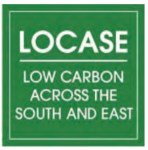 LoCASE
LoCASE
Surrey County Council was a partner in the Low Carbon Across the South and East (LoCASE) programme. LoCASE is supported by the European Regional Development Fund to provide a free business support programme and grant funding of up to £10,000 for small and medium sized enterprises. The aim is to help businesses to become more competitive and profitable while protecting the environment and encouraging low carbon solutions and the creation of green supply chains.
 Insulating Homes
Insulating Homes
Since October 2020 Surrey's Local Authorities, working as a consortium with Action Surrey, have drawn down approximately £29 million in Government funding to decarbonise housing until 2023. This funding prioritises the installation of energy efficiency, low carbon heating and renewable energy in low income, fuel poor homes. Households benefit from warmer homes and lower energy bills. With a top up fund of £750,000 provided by Surrey County Council low income households are eligible for works up to a value of £15,000 per dwelling.
 Zero
Zero
Community-led climate change hubs are springing up across Surrey, including Zero Carbon Guildford and Mole Valley Climate Hub to support faster action on tackling climate change.
 NHS and Surrey Police
NHS and Surrey Police
Public sector bodies are setting ambitious carbon reduction targets. NHS are seeking to be net-zero carbon by 2040 with a net-zero supply chain by 2045. Surrey Police are seeking to decarbonise their buildings and fleet by 2030.
Cycling and walking
New Local Cycling and Walking Infrastructure Plans are being developed to improve cycle paths and footways.
Tree planting
Surrey has set itself a target to facilitate the planting of 1.2 million trees over the next decade. That's one for every resident.
Glossary of terms
- 20 minute neighbourhoods - A high street where residents have easy access to facilities such as schools, shops, restaurants, play areas and medical facilities. By having facilities no more than 20 minute walk away, we can reduce our reliance on cars and reduce our carbon emissions.
- Air pollution - Gases and particles in the air which cause harm to human health or the environment. Man-made air pollution is mainly caused by dust and oxides of sulphur or nitrogen from vehicle exhaust fumes, gas cooking, gas heating and factory emissions.
- Biodiversity - The variety of plant and animal species in the world, or in a particular habitat. A wide variety of plants and animals allows natural spaces to be healthy and also supports services that the land provides to humans such as growing food.
- Biodiversity net gain - An increase in the variety of plant and animal species compared to what was there before, through activities such as tree planting, habitat improvement, creating homes for wildlife or land management.
- Carbon emissions - Gases that cause climate change (also known as greenhouse gases). Carbon dioxide (CO2) is the main gas which is released when fossil fuels are burned. Other greenhouse gases include methane (CH4) and nitrous oxide (N20).
- Circular economy - The aim of a circular economy is one where there is no waste. All items are reused, re-purposed or recycled. Overall, this reduces our consumption and the depletion of our natural resources and prevents pollution such as plastic in the oceans.
- Carbon sequestration - Carbon sequestration refers to the capture and removal of carbon dioxide from the atmosphere with the aim of storing it long term, often through plants and natural habitats (carbon store), with the aim of reducing or reversing climate change.
- Climate change - A change in the Earth's usual average temperature over a long time period that causes unusual weather patterns.
- Climate emergency - A formal recognition that climate change is a serious threat to our way of lives and it needs addressing through emissions reduction and changing our lifestyles. Most Local Authorities in Surrey and across the UK have declared a climate emergency.
- Direct emissions - Direct emissions are greenhouse gases that are emitted through processes that we own or control. These would include the heating in our homes/ offices or from the vehicle we choose to drive.
- Fossil fuels - Fuels that are extracted from underground (sometimes under the seabed) and the products that are made from them. Common fossil fuels include coal, oil, natural gas, petrol and diesel.
- Fossil-fuel based road transport - Cars, trucks, motorbikes and all other forms of road transport that rely on petrol, diesel, natural gas or liquid petroleum gas.
- Heat pump - A form of electric heating that is very efficient.
- Indirect emissions - Indirect emissions are those that occur as a result of something we do or buy, but we don't have direct control over. For example, we might buy a product that is manufactured elsewhere and we cannot directly reduce the emissions from its production.
- Last mile delivery - The last part of a delivery, from a warehouse or hub to the end destination, often direct to the consumer or to a shop.
- Low carbon economy - Many activities that drive our economy use fossil fuels that cause climate change. A low carbon economy is one that uses alternative sources to fossil fuels for the creation of goods and services, to reduce the amount of greenhouse gases emitted.
- Man-made greenhouse gases - Carbon emissions produced by human activity, for example, using petrol in cars are responsible for the climate change we are experiencing today.
- MtCO2e - MtCO2e (million tonnes of carbon dioxide equivalent) is a unit of measurement to explain the quantity of carbon emissions in the atmosphere.
- Natural capital - Natural capital is a term used to describe the stock of the world's natural resources such as air, water, soils, and all living organisms. We rely on these resources for all of our needs and there is a finite stock of many of them, so measuring natural capital is important to be sustainable.
- Net carbon store - The difference between the carbon emissions produced from land (such as emissions from livestock) and the carbon emissions that have been removed from the atmosphere by nature (plants and trees) and stored in tree trunks, leaves, soil or the seabed.
- Net zero carbon target - Overall, no additional carbon emissions are added to the atmosphere, because the amount of greenhouses gases we emit is equal to the amount we remove from the atmosphere (through carbon sequestration or off-setting).
- Pathway to net-zero - What needs to happen to reduce carbon emissions over time to achieve the aim of being net-zero.
- Place-making - Place-making refers to an approach to the planning, design and management of public spaces with the aim of creating neighbourhoods and communities that focus on residents' overall wellbeing.
- Retrofit - An additional component that it did not have when it was made. In a low carbon context retrofit usually refers to the installation of additional insulation, solar panels and low carbon heating into an existing home.

